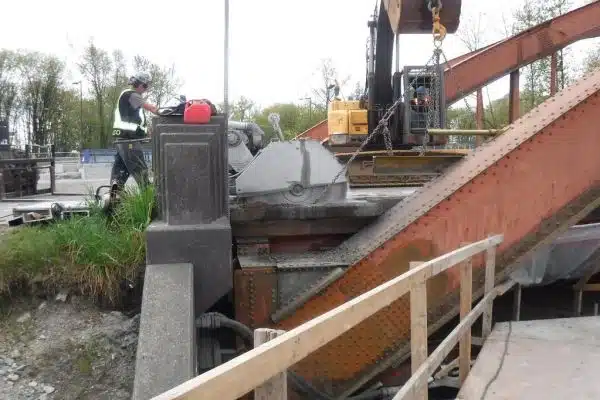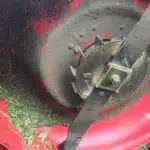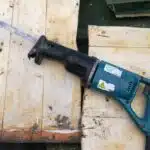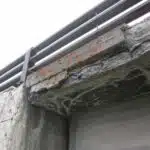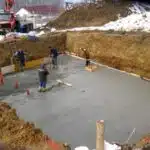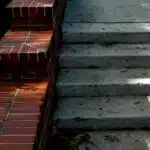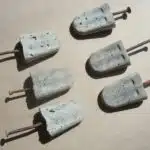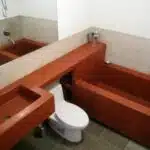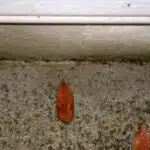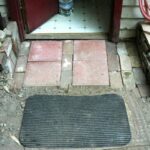When it comes to concrete cutting, making accurate saw cuts is crucial for a successful job. The process requires precision and expertise to ensure that the concrete surface is cut precisely where and how it needs to be. Understanding the basics of where, when, and how to make saw cuts in concrete can help contractors achieve a high level of accuracy and efficiency in their work.
As a concrete cutting expert, I have seen firsthand the importance of proper saw cuts in achieving a quality finished product. Knowing when to make the cuts, where to place them, and what type of saw blade to use are all critical factors that must be considered before beginning any cutting job. To serve our clients with the best possible results, we must approach each project with a deep understanding of these principles and apply our knowledge accordingly.
Understanding Saw Cutting In Concrete
As a concrete cutting expert, I’m constantly amazed by the lack of understanding around saw cutting techniques. It’s as if people think it’s just a matter of grabbing any old saw and getting to work. But the truth is that saw cutting requires precision, expertise, and specialized equipment. Without these factors, you’re likely to end up with a job that falls short of expectations.
When it comes to concrete sawing techniques, there are several key things to keep in mind. First and foremost, you need to understand the nature of concrete itself. This material is incredibly dense and strong, which means that it can be difficult to cut through using traditional methods. That’s why specialized equipment is essential for effective saw cutting.
Speaking of saw cutting equipment, there are a few different types that you might encounter on a job site. These include handheld saws, walk-behind saws, and even flat-sawing machines. Each type has its own unique strengths and weaknesses, so it’s important to choose the right one for the job at hand. By doing so, you’ll be able to achieve accurate cuts that meet your client’s needs and exceed their expectations.
Accurate cuts are essential for any concrete cutting job. In the next section, we’ll explore why this is so important and what steps you can take to ensure that your cuts are always precise and on-target.
Importance Of Accurate Saw Cuts
Precision is crucial when it comes to making saw cuts in concrete. Accurate saw cuts ensure that the concrete remains stable and durable for a long time. Precision is especially important when cutting concrete slabs, beams or walls as it can have an impact on the overall strength of the structure. Therefore, it is essential to use the right tools and techniques to make accurate cuts.
The importance of precision cannot be overstated when making saw cuts in concrete. Even small deviations from the intended line can cause structural damage over time. For example, if a cut is made too deep or too shallow, it can weaken the concrete and affect its durability. To prevent such problems, experienced professionals use specialized equipment such as diamond blades that are designed to make precise cuts.
Achieving accuracy requires careful planning and attention to detail. Before starting a project, it is important to assess the environment and identify any factors that could impact the quality of the cut. This includes factors such as temperature, moisture content and surface texture. By taking these factors into account, experts can determine the best approach for making saw cuts that will result in a strong and durable structure.
- The use of specialized equipment like diamond blades promotes accuracy.
- Accurate saw cuts improve the overall durability of structures.
- Careful planning before starting a project helps identify factors that could impact accuracy.
- Precision ensures that even small deviations do not cause structural damage.
Precision is key when making saw cuts in concrete. It has a significant impact on durability and overall strength of structures. However, achieving accuracy requires careful planning, attention to detail and specialized equipment. In the next section, we will discuss some important factors to consider before making saw cuts in concrete to ensure optimal results for your project.
Factors To Consider Before Making Saw Cuts
As we have previously discussed, accurate saw cuts are essential for ensuring that concrete structures remain stable and durable. However, before making those cuts, there are several factors that must be carefully considered. One of the most important considerations is the surface condition of the concrete. If there are any irregularities or defects on the surface, such as cracks or voids, these can affect the quality and integrity of the cut.
Another critical factor to consider before making saw cuts in concrete is its thickness. The thickness of the concrete will determine how deep the saw cut needs to be to achieve optimal results. For example, if you’re cutting a slab that’s less than four inches thick, a shallow cut of about 1/3 inch should suffice. However, for thicker slabs or structures, deeper cuts may be required to ensure structural stability.
The optimal saw cut depth for different types of concrete applications also varies depending on their specific purposes. For instance, when cutting joints in pavement or sidewalks, a depth between 1/4 and 1/3 of the total thickness is usually recommended. On the other hand, when cutting control joints in larger concrete structures like buildings or bridges, a depth closer to half the total thickness may be necessary. By taking into account all these factors and selecting the appropriate blade for your specific application needs, you can ensure that your saw cuts will provide reliable results every time.
Moving forward with our discussion on concrete cutting techniques and practices we’ll now delve into another crucial aspect: Types of Saw Blades for Concrete Cutting.
Types Of Saw Blades For Concrete Cutting
Diamond blades are the most common type of saw blade used for cutting concrete as they provide the highest level of cutting power and durability. Masonry blades are specifically designed for cutting brick, block, and masonry materials, and are typically used for smaller, more intricate cuts. Carbide blades are ideal for making curved cuts in concrete and are commonly used for cutting rebar and wire mesh. Diamond blades are the most expensive type of saw blade for concrete cutting, but their superior performance and longevity makes them the most cost-effective option. Masonry blades are the least expensive type of saw blade for concrete cutting, but they don’t last as long as diamond blades. Carbide blades offer an ideal balance between cost and performance, and are a good choice for cuts that require precision.
Diamond Blades
As a concrete cutting expert, it is important to understand the significance of diamond blades in the industry. These blades are crucial for efficient and precise cutting of concrete surfaces. However, it is equally important to maintain these blades to ensure their longevity and optimal performance.
Diamond blade maintenance involves proper cleaning and storage after use. Blades should be cleaned thoroughly with water and dried before storing them in a dry place. It is also recommended to periodically inspect the blade for any cracks or damage that may affect its performance.
When selecting a diamond blade, there are several criteria to consider. The type of concrete being cut, the size and power of the equipment used, and the desired finish are all factors that impact blade selection. It is essential to select the right blade for each job to ensure efficiency and quality results.
Overall, diamond blades play a critical role in concrete cutting projects. Proper maintenance and careful consideration during selection can greatly impact the success of each project. As an expert in this field, it is important to stay knowledgeable about new advancements and techniques in diamond blade technology.
Masonry Blades
Masonry saw blade selection is another crucial aspect of concrete cutting that an expert must consider. Masonry saw blades are specifically designed to cut through materials such as brick, block, and stone, which require a different type of blade than concrete. The size and power of the equipment used also play a significant role in masonry saw blade selection.
Proper maintenance of saw blades is essential to ensure optimal performance and longevity. Just like diamond blades, masonry saw blades should be cleaned thoroughly with water and dried after each use. It is also recommended to inspect the blade for any damage or cracks that may affect its performance. Proper storage in a dry place will also help prolong the life of the blade.
When selecting a masonry saw blade, it is important to consider the material being cut and the equipment being used. The hardness of the material will determine whether a soft or hard bond blade is needed. The size and power of the equipment will determine the diameter and thickness of the blade required. Overall, proper selection and maintenance of masonry saw blades can greatly impact the success of concrete cutting projects involving materials such as brick, block, and stone.
Carbide Blades
As a concrete cutting expert, selecting the appropriate type of saw blade is critical for ensuring successful and efficient cutting operations. In addition to masonry blades, carbide blades are another option available for cutting concrete. Carbide blades are made from tungsten carbide and designed to cut through abrasive materials such as concrete, asphalt, and green concrete.
One of the advantages of using carbide blades over diamond blades is their lower cost. While diamond blades may offer superior performance in some cases, they can be quite expensive. Carbide blades provide a more cost-effective solution for those who need to cut through abrasive materials frequently. Furthermore, maintenance of carbide blades is relatively simple compared to diamond blades. A simple cleaning with water after each use and proper storage in a dry place will help prolong the life of the blade.
Although carbide blades may not offer the same level of performance as diamond blades in certain situations, they are still an effective option for many concrete cutting projects. When selecting a blade type, it’s important to consider factors such as material being cut, equipment being used, and desired level of performance. Proper maintenance practices should also be followed regardless of the blade type used to ensure optimal performance and longevity.
Safety Precautions For Saw Cutting
As a professional concrete cutter, safety should be your top priority. Before starting any saw cutting job, ensure that all personnel involved are wearing the necessary safety gear such as eye and ear protection, gloves, and hard hats. It is also important to have a good ventilation system in place to prevent inhalation of dust generated during the process.
Equipment maintenance is another crucial element for safe saw cutting. Regularly inspecting and maintaining your saws and blades can help prevent accidents due to equipment failure. Make sure that all moving parts are properly lubricated, and check for signs of wear or damage on the blades before every use. Always use sharp blades that are appropriate for the material being cut.
Remember that preventing accidents is always better than dealing with them after they happen. Following these safety precautions can help ensure a smooth and incident-free saw cutting process.
Transition: Now that you have taken into consideration the necessary safety precautions for saw cutting, it is time to move on to planning the process itself.
Planning The Saw Cutting Process
Planning the Saw Cutting Process:
Benefits of Planning Proper planning is crucial in any construction project, and saw cutting is no exception. A well-executed plan can greatly reduce errors, increase efficiency, and ultimately save time and money. Before the actual saw cutting process begins, a thorough inspection of the area should be conducted to determine the best locations for cuts. This will help avoid potential damage to underlying structures or pipes. Additionally, a plan that outlines the equipment needed and the number of workers required can ensure that everything is on hand and ready when needed.
Effective Execution Techniques Once a plan is in place, it’s essential to execute it effectively. One technique is to use chalk lines or tape to mark where cuts should be made. This can help ensure straight lines and accurate depths are achieved. It’s also important to choose the right tool for the job. Different types of concrete require different blades and saws, so it’s critical to have the right equipment on hand. Proper blade selection also helps reduce wear and tear on equipment.
When To Make Saw Cuts in Concrete The timing of saw cuts is critical in achieving desired results from concrete surfaces. The ideal time for making saw cuts in fresh concrete depends on several factors such as ambient temperature, humidity levels etc., but typically it’s within 4-12 hours after pouring. Waiting too long could cause unwanted cracking, while making cuts too early can result in rough edges or even collapse of sections due to wetness of concrete mixtures still settling beneath them. Therefore proper planning combined with effective execution techniques will ensure that saw cuts are made at just the right time for optimal results!
When To Make Saw Cuts In Concrete
After careful planning, it is time to consider the factors that determine when to make saw cuts in concrete. Timing is critical, as making the cuts too early or too late can have detrimental effects on the concrete’s structural integrity. Factors to consider include the type of concrete mix used, environmental conditions, and the size and shape of the slab.
One technique to use when deciding when to make saw cuts is to monitor the concrete’s hydration process. This involves monitoring the moisture content and temperature of the concrete over time. As the concrete sets and hardens, it releases heat and loses moisture. By monitoring these factors, you can determine when it is safe to make saw cuts without compromising its strength.
Another technique is to observe cracking patterns that may develop naturally in the concrete during its curing process. These cracks can indicate where saw cuts should be made in order to control cracking and prevent further damage. By making strategic saw cuts at these points, you can control where cracks will form and ensure that they do not compromise the structural integrity of the slab.
In summary, determining when to make saw cuts in concrete requires careful consideration of a variety of factors. Techniques such as monitoring hydration levels and observing natural cracking patterns can help guide this decision-making process. By doing so, you can ensure that your concrete structure remains strong and durable for years to come.
Bullet Point List:
Factors to consider:
- Type of concrete mix used
- Environmental conditions
- Size and shape of slab
- Time required for proper curing
Output with sentence transition:
After careful planning, it is time to consider the factors that determine when to make saw cuts in concrete. Timing is critical, as making the cuts too early or too late can have detrimental effects on the concrete’s structural integrity. Factors to consider include the type of concrete mix used, environmental conditions, and the size and shape of the slab.
One technique to use when deciding when to make saw cuts is to monitor the concrete’s hydration process. This involves monitoring the moisture content and temperature of the concrete over time. As the concrete sets and hardens, it releases heat and loses moisture. By monitoring these factors, you can determine when it is safe to make saw cuts without compromising its strength.
Another technique is to observe cracking patterns that may develop naturally in the concrete during its curing process. These cracks can indicate where saw cuts should be made in order to control cracking and prevent further damage. By making strategic saw cuts at these points, you can control where cracks will form and ensure that they do not compromise the structural integrity of the slab.
To achieve optimal results, it is important to carefully consider when and where to make saw cuts in concrete. The timing of these cuts affects both the strength of the structure and its appearance, while their placement determines how effectively they will prevent future damage. In the next section, we will explore techniques for determining where to place saw cuts for optimal results.
Where To Place Saw Cuts For Optimal Results
Placing saw cuts in concrete is an essential task that needs to be done with precision and accuracy. It is imperative to understand the significance of saw cut depth and spacing, which are crucial factors in determining the overall effectiveness of the cutting process. Choosing the right placement for saw cuts can make all the difference when it comes to achieving optimal results.
Saw cut depth refers to the depth of a cut made using a specialized saw blade. The size of this blade depends on the thickness of the concrete slab being cut. For larger slabs, larger blades will be necessary, while smaller blades may work well for thinner slabs. Saw cut depth is critical as it determines how much stress will be placed on each side of the cut. A shallow saw cut can cause unwanted cracking or damage, while a deep one may result in weakened structural integrity.
Saw cut spacing refers to the distance between each individual saw cut. Proper spacing ensures that there are enough cuts made throughout the concrete slab to prevent unwanted cracking or damage. A general rule-of-thumb is that saw cuts should be spaced at a maximum distance equal to twice their depth. This means that if you have a 1-inch deep saw cut, your maximum recommended spacing would be 2 inches apart. Understanding these key factors will help ensure that your concrete cutting project is successful and achieves optimal results.
Now that we know where to place our saw cuts for optimal results, it’s time to discuss how to make them effectively and efficiently. By following proper procedures such as preparing your tools properly, selecting appropriate safety equipment, and carefully measuring out your cuts before making them, you can ensure success with minimal risk of injury or damage to surrounding structures or surfaces. Let’s dive into these steps further in our next section about how to make saw cuts in concrete.
How To Make Saw Cuts In Concrete
To achieve optimal results when cutting concrete, it is necessary to know where to place saw cuts. In the previous section, we discussed the importance of proper placement, which can prevent cracking and ensure that the concrete remains structurally sound. Now, let’s explore how to make saw cuts in concrete.
Saw cutting equipment is essential for achieving clean and precise cuts in concrete. The type of saw you use will depend on the size and scope of your project. For smaller projects, a handheld saw may suffice, while larger projects may require a walk-behind or ride-on saw. It is important to select a blade that matches the hardness of the concrete.
When making saw cuts in concrete, there are several techniques that can help you achieve straight and accurate cuts. One technique involves using a chalk line or laser level to mark where the cut should be made. Another technique involves using a guide rail to help keep the saw blade on track as it moves along the surface of the concrete. Additionally, it is important to maintain a consistent pace when making cuts to avoid uneven edges.
- Use protective gear such as goggles and earplugs.
- Choose a blade with an appropriate diameter for your project.
- Keep blades clean and sharp for optimal performance.
- Make sure there are no underground utilities in the area you plan to cut.
- Follow all safety protocols when using saw cutting equipment.
In conclusion, knowing where and how to make saw cuts in concrete is crucial for achieving successful results. By selecting the right equipment and utilizing proper techniques such as marking guidelines and maintaining consistency, you can create clean and precise cuts that meet your project needs without compromising structural integrity. Next, we will explore various techniques for making straight saw cuts in more detail.
Techniques For Making Straight Saw Cuts
As a concrete cutting expert, I understand the importance of making straight saw cuts. It is essential to ensure that the cuts are made at the right depth and angle to avoid any damage or cracks in the concrete. Making straight saw cuts requires precision and technique to achieve a clean finish.
One important aspect of making straight saw cuts is depth control. The depth of the cut depends on various factors such as the thickness of the concrete, the purpose of cutting, and the type of blade used. It is crucial to adjust the depth of the blade before cutting to ensure that it goes through without damaging any underlying structures.
Another significant factor in making straight saw cuts is angled cuts. Angled cuts are useful when creating joints or decorative finishes on surfaces like walls and floors. These require careful planning and execution, as they can significantly affect the overall appearance of your project.
| Blade Diameter | Maximum Cutting Depth | Recommended Speed |
|---|---|---|
| 8 inches | 2 inches | 3,000 RPM |
| 12 inches | 4 inches | 2,500 RPM |
| 16 inches | 6 inches | 2,000 RPM |
| 20 inches | 8 inches | 1,500 RPM |
In conclusion, making straight saw cuts in concrete requires attention to detail and an understanding of how to control blade depth and angles. With proper technique and equipment, you can achieve a precise cut that meets your project’s requirements. In the next section, we will explore techniques for making curved saw cuts that can help you elevate your next project’s design even further.
Techniques For Making Curved Saw Cuts
Types of Saws used for curved saw cuts should be chosen based on the material being cut, as well as the desired size, shape, and depth of the cut. Saw placement should be planned carefully, taking into account the speed, angle, and depth of the cut. Safety must be a priority when making curved saw cuts, and all necessary precautions should be taken to ensure the cleanliness, marking, and preparation of the worksite. Finally, practice, patience, precision, dust control, follow-up, and maintenance are essential to successful curved saw cutting.
Types Of Saws
When it comes to making curved saw cuts on concrete, choosing the right type of saw is critical. There are two main types of saws: hand and power. Hand saws are manually operated and require significant effort to make precise cuts. On the other hand, power saws are electrically or gas-powered and offer greater precision and speed. Depending on your specific needs, you may choose between a handheld circular saw, a walk-behind saw, or a track-mounted wall saw.
Additionally, when selecting a saw for your concrete cutting project, you must consider whether to use wet or dry cutting methods. Wet cutting involves using water to cool down the blade during operation and reduce dust levels. This method is ideal for larger projects that require extended periods of cutting time since it prolongs the life of the blade. However, dry cutting is suitable for smaller projects where dust control is not as much of an issue.
Choosing the right type of saw will ultimately depend on various factors such as project size, budget constraints, and desired level of precision. For example, if you need to cut through thick slabs of concrete quickly and efficiently, a walk-behind or track-mounted wall saw may be more appropriate than a handheld circular saw. Ultimately, carefully considering your options before making any decisions will help you select the best tool for your specific needs.
Saw Placement
To achieve a precise and accurate curved saw cut on concrete, the placement of the saw is just as important as selecting the right type of saw. The position of the saw can greatly affect the quality and depth of the cut. Saw placement is especially crucial when dealing with thicker concrete slabs, where an incorrect placement can cause uneven cuts or even damage to the blade.
When making curved saw cuts on concrete, it’s important to ensure that the saw blade is properly aligned with the cutting pattern. The blade should be positioned perpendicular to the surface of the concrete and at a consistent angle throughout the entire cut. This will help maintain a smooth and consistent cutting depth while minimizing any risk of chipping or cracking.
Another key factor in saw placement is controlling the cutting speed. When making curved cuts, it’s essential to maintain a steady pace throughout each pass without applying too much pressure on any one section. This will prevent overheating and premature wear on the blade, ultimately leading to better results in terms of precision and efficiency. By paying close attention to these factors, you can achieve exceptional results when making curved saw cuts on concrete.
Common Mistakes To Avoid In Saw Cutting
As a concrete cutting expert, it is my duty to share with you the common mistakes that people make when sawing concrete. One of the biggest mistakes that people make is improper blade selection. Choosing the wrong blade can lead to inefficiency and even damage to the saw. It is important to select a blade that is compatible with your saw and appropriate for the type of material you are cutting.
Another mistake that people often make when sawing concrete is using a dull or damaged blade. A dull blade not only slows down the cutting process but also puts unnecessary strain on the motor, which could ultimately lead to overheating and damage. It is important to maintain sharp blades at all times, and if a blade becomes damaged, it should be replaced immediately.
Finally, one of the most common mistakes in saw cutting is improper technique. This includes incorrect positioning of the saw, improper depth setting, and lack of proper safety measures. To avoid these mistakes, it’s crucial to follow proper techniques for making saw cuts in concrete. Always ensure that your saw is properly positioned and leveled before starting any cuts. Additionally, always wear proper safety gear such as gloves, goggles, and ear protection.
Maintaining your saw for optimal performance requires regular maintenance and care. In the next section, we will discuss some helpful tips for maintaining your saw so that it continues to perform at its best level possible.
Maintaining Your Saw For Optimal Performance
A well-maintained saw is like a sharp knife in the hands of a chef – it allows for precise and efficient cuts. As a concrete cutting expert, I cannot stress enough the importance of tool maintenance to achieve the desired results. While saws are durable tools, they require regular care to ensure optimal performance.
To keep your saw running smoothly, follow these four maintenance tips:
- Keep the air filter clean and replace it regularly.
- Check the oil level before every use and change it according to the manufacturer’s recommendations.
- Inspect the blade regularly for wear and tear or damage.
- Use only high-quality fuel to prevent engine damage.
Even with proper maintenance, issues may arise with your saw. If you encounter problems such as difficulty starting, loss of power, or unusual vibrations, don’t panic! Troubleshooting techniques such as checking spark plugs or cleaning carburetors can often resolve these issues.
In summary, maintaining your saw is crucial to achieving excellent results in concrete cutting projects. By following simple maintenance tips and troubleshooting techniques, you can avoid costly repairs and maximize your tool’s lifespan. In the next section, we will discuss how to choose the right contractor for saw cutting projects.
Choosing The Right Contractor For Saw Cutting
When it comes to saw cutting, finding the right contractor for your project is crucial. Not all contractors are created equal, and choosing the wrong one can lead to costly mistakes that could have been avoided. When selecting a contractor, it is essential to consider their credentials carefully. Look for a contractor who has experience in the type of project you need saw cutting services for and has positive reviews from previous clients.
Pricing options should also be considered when choosing a contractor for saw cutting. While it may be tempting to go with the cheapest option, keep in mind that quality work often comes at a higher cost. Contractors with lower pricing options may cut corners or use inferior equipment, leading to subpar results. It’s better to invest in a reputable contractor who charges more but delivers high-quality work.
When selecting a contractor for saw cutting services, take your time and do your research. Don’t rush into making a decision based on price alone. Consider the contractor’s credentials and pricing options carefully before making your final choice. Remember, choosing the right contractor can make all the difference in achieving successful results for your concrete project.
With the right contractor selected, you can now move forward with confidence knowing that your project is in capable hands. In our next section, we will explore how quality saw cuts can benefit concrete projects by reducing cracking and improving overall durability.
Benefits Of Quality Saw Cuts In Concrete Projects
Like a sculptor chiseling away at a block of marble, a skilled saw cutter must know precisely where to make their cuts in concrete. Taking the time to plan out and execute the proper techniques for saw cutting can result in significant advantages for any concrete project.
One of the most significant advantages of quality saw cuts is that they prevent uncontrolled cracking in the concrete. By strategically placing cuts before any cracks appear, contractors can control where the concrete will crack and minimize damage to surrounding areas. Additionally, precise cuts improve the overall appearance of the finished project, creating clean lines and smooth surfaces.
To achieve these benefits, there are several techniques that saw cutters use to ensure accurate and consistent results. Among these tools are electric or gas-powered saws with diamond blades capable of cutting through various types of concrete. Additionally, using joint sealants or fillers after making saw cuts can further enhance their effectiveness by preventing water infiltration and protecting against erosion.
By utilizing these techniques and taking care to make precise saw cuts in concrete, contractors can avoid costly repairs and improve their overall efficiency on job sites. With each successful project, they contribute to safer and more aesthetically pleasing communities for all who inhabit them.
Conclusion
In conclusion, the art of saw cutting in concrete is a critical process that requires precision and expertise. A successful concrete project depends on accurate cuts made at the right time, location, and depth. It is essential to consider several factors before making saw cuts, including weather conditions, concrete age, and the type of blade used.
Furthermore, maintaining your saw for optimal performance and adhering to safety precautions during the cutting process are paramount to prevent accidents and injuries. Choosing a reputable contractor with experience in saw cutting can ensure quality workmanship and timely completion of your project.
In summary, accurate saw cuts are essential for any successful concrete project. They require careful planning, attention to detail, and adherence to safety protocols. With the right tools, knowledge, and expertise from a professional contractor, you can achieve precise cuts that meet your project’s needs. Remember that every cut counts; therefore, it is crucial to get it right the first time around.
Image Credits
- “Apr 20 20 BOB-saw cutting the concrete north deck edge sections” by TranBC (featured)

